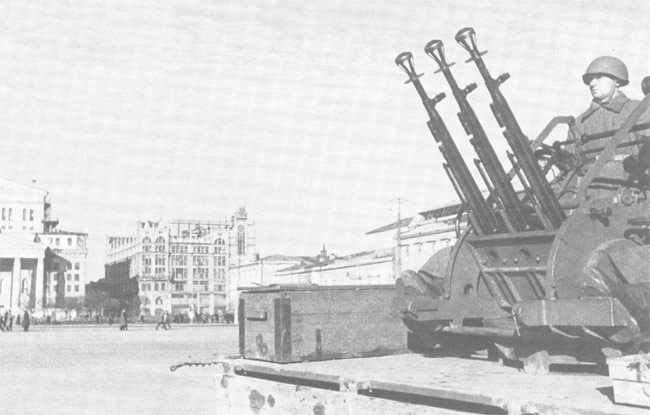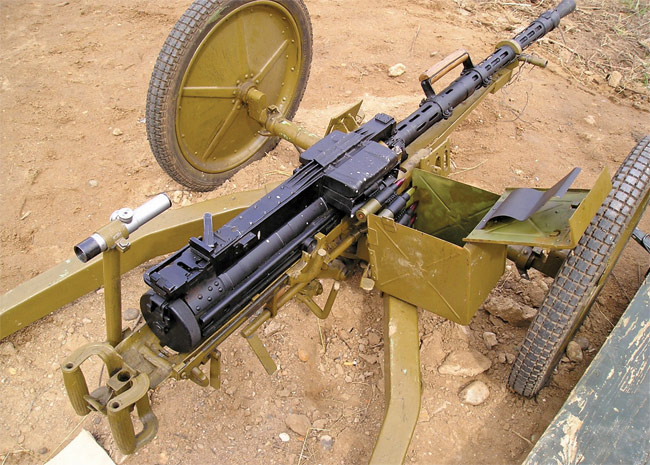– – DShK, DShKM – –
Caliber: 12.7×108
Weight: 34 kg (75 lbs) gun body + 102 kg (225 lbs) universal mount (less shield and shoulder rest for AA applications)
Overall length: 1,630 mm (64”)
Barrel length: 1,070 mm (42”)
Cyclic rate of fire: 550-600 rpm
Feed and capacity: Belt, 50 rounds
The DShK is a gas operated, belt fed, air cooled machine gun that fires from an open bolt and in automatic mode only. The gas piston and chamber are located below the barrel; the gas piston is of the long stroke type, and is attached to the bolt carrier. The gas chamber is fitted with a gas regulator, which requires a special wrench to make adjustments. The bolt, of generally rectangular cross-section, locks into the receiver with two outwardly pivoting flaps. These flaps are pushed outwards from the bolt to lock it by the enlarged firing pin, which in turn is operated by the vertical projection on the bolt carrier. The rear of the receiver houses two spring buffers, one for the bolt and one for the bolt carrier.
The heavy barrel is finned for better cooling, and is fitted with a large muzzle brake. The barrel can be detached from the weapon, but it hardly can be called “quick detachable,” it is screwed into the front of the receiver, and then fixed there by the cross-bolt, which is also screwed in place.
The ammunition feed is via non-disintegrating steel belts, from the left side only. The belt feed unit was designed as an afterthought for the originally magazine-fed DK machine gun, so it is clamped to the top of the receiver. It consists of a squirrel-cage type wheel that is operated by a swinging arm at the right side of the gun. This arm, in turn, is operated by the reciprocating round projection, which is located on the right side of the bolt carrier. The belt enters the circular feed unit at the top, and cartridges are carried clockwise (when looking from the rear of the gun). Upon discharge, the bolt carrier goes back on its recoil stroke, pulling the belt feed hand and rotating the feed wheel by 1/6th of a turn. Upon rotation, the belt is pulled across the unit, and cartridges are stripped down from the belt pockets by dual claw-shaped strippers. Once the cartridge reaches its bottom position in the feed unit, it is stripped forward into the chamber by the bolt. Spent cartridges are ejected down through openings in the receiver and bolt carrier. The charging handle of DShK is rather stubby, and to cock the gun comfortably one must insert a base of a live cartridge or spent case into a hole drilled in the handle and use this extension to retract the bolt group.
In manual (ground and AA) applications the gun is fitted with dual spade grips at the back of the receiver, and a dual trigger. The charging handle is also shaped as a spade grip, and is located horizontally below and between spade grips.
Standard sighting equipment consists of a hooded front post, adjustable for zeroing, and a folding frame-type rear sight, adjustable for range (up to 3,500 m in 100 m increments) and windage. Additional anti-aircraft sights can be installed for AA use.
The standard mount is a universal setup, which can be used for both ground and AA roles. Designed by Kolesnikov, this mount consists of a detachable two-wheel base and three folding legs, which form the tail-boom for ground applications and are extended to form a tripod for AA applications. Kolesnikov mounts were issued with heavy armoured shields, but crews often discarded shields to save some weight and to decrease the gun profile when firing from wheels. In the AA role, both wheels and shield were detached from the mount, and an optional shoulder support can be installed.
Modifications
DShKM (modernized, also known as DShKM 38/46). The key improvements of the DShKM were a simplified belt feed and an improved barrel fixing method. Other changes included an improved muzzle brake and minor modifications to other parts, which made the gun more durable. The new belt feed retained the same “add-on” profile and operating arm, which connected the belt feed with the reciprocating bolt handle. However, the rotating wheel was replacing by a lateral slider system, which permitted the feed direction to be switched (a feature, most useful for multiple AA and tank mounts).
Type 54 (China): a licensed copy of DShKM produced in China; recently manufacture has been transferred from China to Pakistan, where this weapon is still manufactured under same Type 54 designation by Pakistan Ordnance factories.
– – KPV KPVT – –
Caliber: 14.5×114
Weight: 49.1kg (108 lbs) + 105 kg (231 lbs) wheeled infantry mount or 39 kg (86 lbs) infantry tripod
Overall length: 2,006 mm (79”)
Barrel length: 1,346 mm (53”)
Cyclic rate of fire: 600 rpm
Feed and capacity: Belt, 40 (KPV) or 50 (KPVT) rounds
The KPV entered small-scale production in 1944, and was officially adopted by the Soviet army in 1949 for ground and AA use, in infantry (ground-fire only) version with a wheeled mount designed by Kharanin, and in a number of dedicated AA mounts; single, twin and quadruple. In 1955 the heavy Kharanin mount was replaced in production by a lighter tripod designed by Baryshev. Guns produced prior to 1955 retained their wheeled mounts and both version saw significant use during the Soviet invasion of Afghanistan. The infantry version of this gun had a relatively short production life, being replaced by the improved KPVT (tank) version, which is used for both armoured vehicles and dedicated AA mounts, as well as in naval mounts for light patrol vessels.
The Vladimirov KPV is a short-recoil operated, locked breech, air cooled, belt fed weapon. Bolt to barrel locking is achieved by the rotating bolt collar that has a set of interrupted thread lugs on its inner surface. These lugs engage cuts made on the breech of the barrel. Barrels can be quickly replaced along with perforated barrel jackets. The carrying handle is attached to the barrel jacket. The bolt collar is rotated upon recoil by the cross-pin that follows the cam track. The firing pin is permanently fixed to the bolt face and can strike the primer of the cartridge only when bolt is completely locked to the barrel.
The KPV is fed using disintegrating steel belts. The feed is of the two-stage type, with the cartridges first being pulled back out of the belt, then placed into a T-slot cut in the breech face. Spent cases are first pushed down and out of the T-slot by a fresh cartridge, and then either fall down through the ejection opening (on original infantry guns) or are ejected forward through the short tube (on modern KPVT guns). The final spent case is pushed out of the bolt slot by a special ejector lever. Belt feed direction can be easily adjusted for left- or right-side feeding.
The original infantry mount, designed by Kharanin, was more or less like a small artillery mount, with two large steel wheels with rubber tires, and dual tail booms used to tow the HMG behind a jeep or light truck, and to steady it in the firing position. Baryshev type tripods were significantly lighter, and infantry KPV guns were most often used at fixed checkpoints or incorporated into base defenses. Various AA type mounts included lightweight “mountain” ones with single guns, and heavier towed twin and quadruple mounts, which had traverse and elevation mechanisms plus special sighting equipment and were usually manned by two operators and a number of loaders / assistants.






